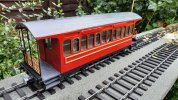Greg Elmassian
Guest
I think that 3d printing throws a curve at terms we have used for years.
I'm a proponent of letting the builder use the term "scratch built" as he wants.
The people whose work really impresses me, whether buildings, like Ray Dunakin (here in San Diego) and Jaime here on this forum, don't even thump their chests and claim this or that, they show their work and it speaks for itself. I would also accept someone that severely bashed a kit, adding/changing walls, moving/modifying windows. But people who I respect that do this again do not thump their chests and claim scratch building, often they use the term "bash" as a combination/modification of components.
In locomotives, scratch building could be so tightly defined as you would have to make your own motor. Normally using a commercial motor and commercial wheels but the majority machined/created by the builder is "scratch built"... We have a person on another forum who is a great example, Bille on MLS: Building the John Wilkes
Again, the respected people are almost always modest, and just present their work. People will say: I started with these pieces I had to buy, etc.
And again, I have several "bashed" locos, a Northern, a 2-10-2 Mountain, and E8B, all of which were never produced by Aristo Craft, but skillfully bashed by Rex Ammerman, who never has called himself a scratchbuilder.

So I would submit that people arguing about it, just waste time.
I see where a person who has a pretty "strict" definition of scratch building would really not agree that anything 3D printed could be scratch building from his perspective, I get it.
But why argue? Right now, if you can get a loco 3d printed to look that good, you have solved some very difficult problems with wheels, valve gear, fine detail, etc. So far, I have not seen any loco 3d printed with details and surface quality that has impressed me, unless HOURS of finishing was involved, and that work I would respect.
So, I think let anyone call their work scratch built if they want, visual observation will tell the story as to what the result is. I'm waiting to be impressed with 3D printing steam locos and diesels.
Greg
I'm a proponent of letting the builder use the term "scratch built" as he wants.
The people whose work really impresses me, whether buildings, like Ray Dunakin (here in San Diego) and Jaime here on this forum, don't even thump their chests and claim this or that, they show their work and it speaks for itself. I would also accept someone that severely bashed a kit, adding/changing walls, moving/modifying windows. But people who I respect that do this again do not thump their chests and claim scratch building, often they use the term "bash" as a combination/modification of components.
In locomotives, scratch building could be so tightly defined as you would have to make your own motor. Normally using a commercial motor and commercial wheels but the majority machined/created by the builder is "scratch built"... We have a person on another forum who is a great example, Bille on MLS: Building the John Wilkes
Again, the respected people are almost always modest, and just present their work. People will say: I started with these pieces I had to buy, etc.
And again, I have several "bashed" locos, a Northern, a 2-10-2 Mountain, and E8B, all of which were never produced by Aristo Craft, but skillfully bashed by Rex Ammerman, who never has called himself a scratchbuilder.

So I would submit that people arguing about it, just waste time.
I see where a person who has a pretty "strict" definition of scratch building would really not agree that anything 3D printed could be scratch building from his perspective, I get it.
But why argue? Right now, if you can get a loco 3d printed to look that good, you have solved some very difficult problems with wheels, valve gear, fine detail, etc. So far, I have not seen any loco 3d printed with details and surface quality that has impressed me, unless HOURS of finishing was involved, and that work I would respect.
So, I think let anyone call their work scratch built if they want, visual observation will tell the story as to what the result is. I'm waiting to be impressed with 3D printing steam locos and diesels.
Greg

